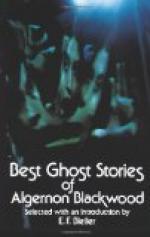“Responsa 12^{mi} Dec. 1694. Interrogatum est: Inveniamne? Responsum est: Invenies. Fiamne dives? Fies. Vivamne invidendus? Vives. Moriarne in lecto meo? Ita.” (Answers of the 12th of December, 1694. It was asked: Shall I find it? Answer: Thou shalt. Shall I become rich? Thou wilt. Shall I live an object of envy? Thou wilt. Shall I die in my bed? Thou wilt.)
“A good specimen of the treasure-hunter’s record—quite reminds one of Mr. Minor-Canon Quatremain in ‘Old St. Paul’s,’” was Dennistoun’s comment, and he turned the leaf.
What he then saw impressed him, as he has often told me, more than he could have conceived any drawing or picture capable of impressing him. And, though the drawing he saw is no longer in existence, there is a photograph of it (which I possess) which fully bears out that statement. The picture in question was a sepia drawing at the end of the seventeenth century, representing, one would say at first sight, a Biblical scene; for the architecture (the picture represented an interior) and the figures had that semi-classical flavor about them which the artists of two hundred years ago thought appropriate to illustrations of the Bible. On the right was a king on his throne, the throne elevated on twelve steps, a canopy overhead, soldiers on either side—evidently King Solomon. He was bending forward with outstretched scepter, in attitude of command; his face expressed horror and disgust, yet there was in it also the mark of imperious command and confident power. The left half of the picture was the strangest, however. The interest plainly centered there. On the pavement before the throne were grouped four soldiers, surrounding a crouching figure which must be described in a moment. A fifth soldier lay dead on the pavement, his neck distorted, and his eyeballs starting from his head. The four surrounding guards were looking at the King. In their faces the sentiment of horror was intensified; they seemed, in fact, only restrained from flight by their implicit trust in their master. All this terror was plainly excited by the being that crouched in their midst. I entirely despair of conveying by any words the impression which this figure makes upon any one who looks at it. I recollect once showing the photograph of the drawing to a lecturer on morphology—a person of, I was going to say, abnormally sane and unimaginative habits of mind. He absolutely refused to be alone for the rest of that evening, and he told me afterwards that for many nights he had not dared to put out his light before going to sleep. However, the main traits of the figure I can at least indicate. At first you saw only a mass of coarse, matted black hair; presently it was seen that this covered a body of fearful thinness, almost a skeleton, but with the muscles standing out like wires. The hands were of a dusky pallor, covered, like the body, with long, coarse hairs, and hideously taloned. The eyes, touched in with a




